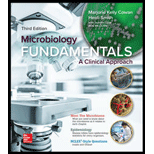
Concept explainers
Which of the following microbes have evolved an intracellular life style?
- a. Bacillus anthracis
- b. Coxiella burnetii
- c. MRSA
- d. two of these
Introduction:
Bacteria are defined as small, microscopic, prokaryotic and unicellular organisms that are not seen by naked eyes. They are found everywhere in nature and hence, are called ubiquities.
Answer to Problem 1Q
Correct answer:
The microbes such as Coxiella burnetii have evolved an intracellular life style. Therefore, option (b) is correct.
Option (b) is given as “Coxiella burnetii”.
Explanation of Solution
Justify reason for the correct statement:
The bacteria Coxiella burnetii is an obligate intracellular pathogen which has evolved and able to survive in harsh conditions inside the intracellular compartments of cells called as phagolysosome. Inside it, the Coxiella phagosome is further developed into large and spacious parasitophorous vacuole. This parasitophorous vacuole has all characteristics of lysosome such as acidic pH, acid hydrolase enzyme and cationic peptides. It provides a defense against host invaders.
Hence, option (b) is correct.
Justify reasons for the incorrect statements:
Option (a) is given as “Bacillus anthracis”.
The life cycle of Bacillus anthracis involves two alternate phages such as vegetative and endospores on the basis of availability of nutrients. Hence, it is a wrong answer.
Option (c) is given as “MRSA”.
It is denoted as methicilin-resistant Staphylococcus aureus and forms colonies for division. Hence, it is a wrong answer.
Option (d) is given as “two of these”.
Coxiella burnetii have evolved to follow intracellular life style. Hence, it is a wrong answer.
Hence, options (a), (c), and (d) are incorrect.
The bacterium Coxiella burnetii is an obligate intracellular pathogen which has evolved and able to survive in harsh conditions inside the intracellular compartments of cells called as phagolysosome.
Want to see more full solutions like this?
Chapter 18 Solutions
Microbiology Fundamentals: A Clinical Approach
- Explain in a small summary how: What genetic information can be obtained from a Punnet square? What genetic information cannot be determined from a Punnet square? Why might a Punnet Square be beneficial to understanding genetics/inheritance?arrow_forwardIn a small summary write down:arrow_forwardNot part of a graded assignment, from a past midtermarrow_forward
- Noggin mutation: The mouse, one of the phenotypic consequences of Noggin mutationis mispatterning of the spinal cord, in the posterior region of the mouse embryo, suchthat in the hindlimb region the more ventral fates are lost, and the dorsal Pax3 domain isexpanded. (this experiment is not in the lectures).a. Hypothesis for why: What would be your hypothesis for why the ventral fatesare lost and dorsal fates expanded? Include in your answer the words notochord,BMP, SHH and either (or both of) surface ectoderm or lateral plate mesodermarrow_forwardNot part of a graded assignment, from a past midtermarrow_forwardNot part of a graded assignment, from a past midtermarrow_forward
 Comprehensive Medical Assisting: Administrative a...NursingISBN:9781305964792Author:Wilburta Q. Lindh, Carol D. Tamparo, Barbara M. Dahl, Julie Morris, Cindy CorreaPublisher:Cengage Learning
Comprehensive Medical Assisting: Administrative a...NursingISBN:9781305964792Author:Wilburta Q. Lindh, Carol D. Tamparo, Barbara M. Dahl, Julie Morris, Cindy CorreaPublisher:Cengage Learning Medical Terminology for Health Professions, Spira...Health & NutritionISBN:9781305634350Author:Ann Ehrlich, Carol L. Schroeder, Laura Ehrlich, Katrina A. SchroederPublisher:Cengage Learning
Medical Terminology for Health Professions, Spira...Health & NutritionISBN:9781305634350Author:Ann Ehrlich, Carol L. Schroeder, Laura Ehrlich, Katrina A. SchroederPublisher:Cengage Learning- Basic Clinical Lab Competencies for Respiratory C...NursingISBN:9781285244662Author:WhitePublisher:Cengage






